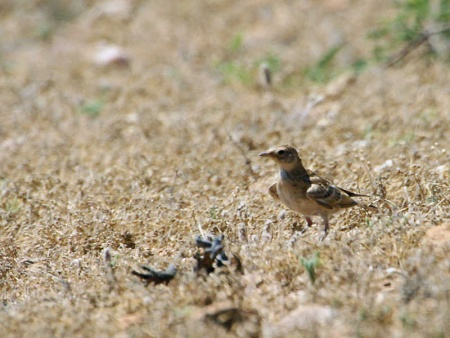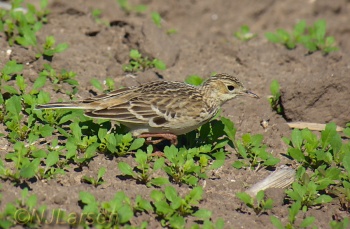- Anthus spragueii
Identification
15–17 cm (6-6¾ in) Sexes similar.
- Brown striped overall plumage
- White outer tail feathers
- Crown, nape, and upperparts streaked black and buff
- Wings with two white wingbars.
- Upper breast finely streaked, rest of underside mostly unmarked.
- Pale mostly unmarked face with white eyering makes dark brown eye seem large.
- Bill is thin and mostly pink, legs yellow or pinkish.
Distribution
North America
Breeds in the northern central plains in Canada (Alberta, Saskatchewan, Manitoba) and United States (Montana, North Dakota and South Dakota).
Winters in southern United States (Oklahoma, Texas, New Mexico, and Arizona has the majority of the birds) and Mexico (northern and central).
Taxonomy
Habitat
Prairies, open grasslands and weedy fields; also agricultural areas in winter.
Behaviour
Diet
The diet consists mostly of insects such as beetles and grasshoppers, also spiders, with the addition of some weed seeds. It forages on the ground, singly or in pairs, usually well concealed, but occasionally out in the open.
Breeding
The male displays by flying up to around 100 m and sings with the tail spread. He circles round then plummets to the ground with the wings closed.
The nest is a cup woven from fine grass which is placed on the ground. Some nests are protected by a tent of long grasses, which sometimes forms a complete dome. The clutch consists of 4-6 pale whitish eggs with brown blotches.
References
- Clements, J. F., T. S. Schulenberg, M. J. Iliff, D. Roberson, T. A. Fredericks, B. L. Sullivan, and C. L. Wood. 2015. The eBird/Clements checklist of birds of the world: v2015, with updates to August 2015. Downloaded from http://www.birds.cornell.edu/clementschecklist/download/
- Ebird.org
- Howell & Webb, 1995. A guide to the birds of Mexico and northern Central America. Oxford University Press. ISBN 0198540124
- Handbook of the Birds of the World Alive (retrieved February 2016)
Cornell, All About Birds
Recommended Citation
- BirdForum Opus contributors. (2024) Sprague's Pipit. In: BirdForum, the forum for wild birds and birding. Retrieved 18 April 2024 from https://www.birdforum.net/opus/Sprague%27s_Pipit






